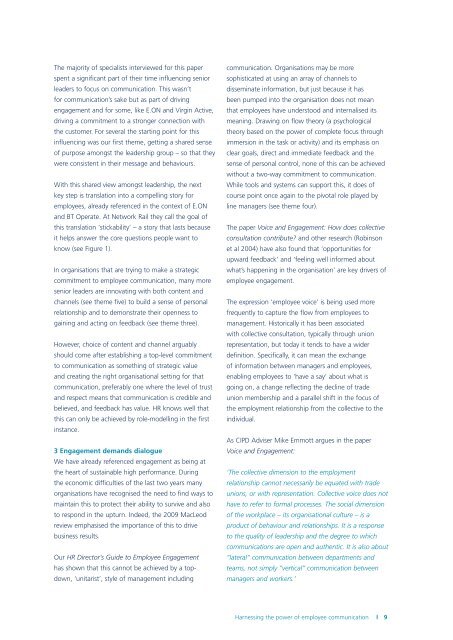Harnessing the power of employee communication - CIPD
Harnessing the power of employee communication - CIPD
Harnessing the power of employee communication - CIPD
Create successful ePaper yourself
Turn your PDF publications into a flip-book with our unique Google optimized e-Paper software.
The majority <strong>of</strong> specialists interviewed for this paper<br />
spent a significant part <strong>of</strong> <strong>the</strong>ir time influencing senior<br />
leaders to focus on <strong>communication</strong>. This wasn’t<br />
for <strong>communication</strong>’s sake but as part <strong>of</strong> driving<br />
engagement and for some, like E.ON and Virgin Active,<br />
driving a commitment to a stronger connection with<br />
<strong>the</strong> customer. For several <strong>the</strong> starting point for this<br />
influencing was our first <strong>the</strong>me, getting a shared sense<br />
<strong>of</strong> purpose amongst <strong>the</strong> leadership group – so that <strong>the</strong>y<br />
were consistent in <strong>the</strong>ir message and behaviours.<br />
With this shared view amongst leadership, <strong>the</strong> next<br />
key step is translation into a compelling story for<br />
<strong>employee</strong>s, already referenced in <strong>the</strong> context <strong>of</strong> E.ON<br />
and BT Operate. At Network Rail <strong>the</strong>y call <strong>the</strong> goal <strong>of</strong><br />
this translation ‘stickability’ – a story that lasts because<br />
it helps answer <strong>the</strong> core questions people want to<br />
know (see Figure 1).<br />
In organisations that are trying to make a strategic<br />
commitment to <strong>employee</strong> <strong>communication</strong>, many more<br />
senior leaders are innovating with both content and<br />
channels (see <strong>the</strong>me five) to build a sense <strong>of</strong> personal<br />
relationship and to demonstrate <strong>the</strong>ir openness to<br />
gaining and acting on feedback (see <strong>the</strong>me three).<br />
However, choice <strong>of</strong> content and channel arguably<br />
should come after establishing a top-level commitment<br />
to <strong>communication</strong> as something <strong>of</strong> strategic value<br />
and creating <strong>the</strong> right organisational setting for that<br />
<strong>communication</strong>, preferably one where <strong>the</strong> level <strong>of</strong> trust<br />
and respect means that <strong>communication</strong> is credible and<br />
believed, and feedback has value. HR knows well that<br />
this can only be achieved by role-modelling in <strong>the</strong> first<br />
instance.<br />
3 Engagement demands dialogue<br />
We have already referenced engagement as being at<br />
<strong>the</strong> heart <strong>of</strong> sustainable high performance. During<br />
<strong>the</strong> economic difficulties <strong>of</strong> <strong>the</strong> last two years many<br />
organisations have recognised <strong>the</strong> need to find ways to<br />
maintain this to protect <strong>the</strong>ir ability to survive and also<br />
to respond in <strong>the</strong> upturn. Indeed, <strong>the</strong> 2009 MacLeod<br />
review emphasised <strong>the</strong> importance <strong>of</strong> this to drive<br />
business results.<br />
Our HR Director’s Guide to Employee Engagement<br />
has shown that this cannot be achieved by a topdown,<br />
‘unitarist’, style <strong>of</strong> management including<br />
<strong>communication</strong>. Organisations may be more<br />
sophisticated at using an array <strong>of</strong> channels to<br />
disseminate information, but just because it has<br />
been pumped into <strong>the</strong> organisation does not mean<br />
that <strong>employee</strong>s have understood and internalised its<br />
meaning. Drawing on flow <strong>the</strong>ory (a psychological<br />
<strong>the</strong>ory based on <strong>the</strong> <strong>power</strong> <strong>of</strong> complete focus through<br />
immersion in <strong>the</strong> task or activity) and its emphasis on<br />
clear goals, direct and immediate feedback and <strong>the</strong><br />
sense <strong>of</strong> personal control, none <strong>of</strong> this can be achieved<br />
without a two-way commitment to <strong>communication</strong>.<br />
While tools and systems can support this, it does <strong>of</strong><br />
course point once again to <strong>the</strong> pivotal role played by<br />
line managers (see <strong>the</strong>me four).<br />
The paper Voice and Engagement: How does collective<br />
consultation contribute? and o<strong>the</strong>r research (Robinson<br />
et al 2004) have also found that ‘opportunities for<br />
upward feedback’ and ‘feeling well informed about<br />
what’s happening in <strong>the</strong> organisation’ are key drivers <strong>of</strong><br />
<strong>employee</strong> engagement.<br />
The expression ‘<strong>employee</strong> voice’ is being used more<br />
frequently to capture <strong>the</strong> flow from <strong>employee</strong>s to<br />
management. Historically it has been associated<br />
with collective consultation, typically through union<br />
representation, but today it tends to have a wider<br />
definition. Specifically, it can mean <strong>the</strong> exchange<br />
<strong>of</strong> information between managers and <strong>employee</strong>s,<br />
enabling <strong>employee</strong>s to ‘have a say’ about what is<br />
going on, a change reflecting <strong>the</strong> decline <strong>of</strong> trade<br />
union membership and a parallel shift in <strong>the</strong> focus <strong>of</strong><br />
<strong>the</strong> employment relationship from <strong>the</strong> collective to <strong>the</strong><br />
individual.<br />
As <strong>CIPD</strong> Adviser Mike Emmott argues in <strong>the</strong> paper<br />
Voice and Engagement:<br />
‘The collective dimension to <strong>the</strong> employment<br />
relationship cannot necessarily be equated with trade<br />
unions, or with representation. Collective voice does not<br />
have to refer to formal processes. The social dimension<br />
<strong>of</strong> <strong>the</strong> workplace – its organisational culture – is a<br />
product <strong>of</strong> behaviour and relationships. It is a response<br />
to <strong>the</strong> quality <strong>of</strong> leadership and <strong>the</strong> degree to which<br />
<strong>communication</strong>s are open and au<strong>the</strong>ntic. It is also about<br />
“lateral” <strong>communication</strong> between departments and<br />
teams, not simply “vertical” <strong>communication</strong> between<br />
managers and workers.’<br />
<strong>Harnessing</strong> <strong>the</strong> <strong>power</strong> <strong>of</strong> <strong>employee</strong> <strong>communication</strong> 9

















